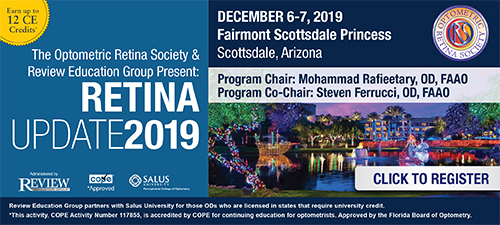
A
weekly e-journal by Art Epstein, OD, FAAO
Off the Cuff: New Paradigms in Prescribing
One of the greatest moments in my professional career was the day I received my first Rx pads and wrote my first prescription. Now, thousands of Rxs’ later, among the most frustrating parts of my day is writing a prescription. I need not tell you how much prescribing has changed over a relatively short period, but writing an Rx today is a complicated nightmare of prior authorizations, pharmacy call backs and prescription denials. At its core are greedy insurance companies and their formulary middlemen, exorbitant drug prices, government lunacy and finger pointing at everyone by everyone. In the end, we are left weary, and our patients frustrated and angry. I am sick and tired of my patients not being able to get what I prescribe. My staff is fed up with being abused by a system that gets in the way of quality patient care. I know I am not alone. Thankfully, several companies are starting to do something about it. About two years ago, I was approached by Novartis to gauge my interest in helping create an alternative drug delivery model that would get much-needed class-leading branded medications to our patients at affordable prices without interference and added costs imposed by health insurers. I gladly accepted.
|
|||||
 |
||
| Pterygium is Related to Short Axial Length | ||||
A retrospective, hospital-based, cross-sectional study including 521 eyes from 521 patients who were enrolled through a community survey by Shanghai Heping Eye Hospital was conducted to test the hypothesis that pterygium presents with both refractive and anatomical changes, especially short axial length. Patients with primary pterygium in at least one eye were considered the pterygium group, and those with normal eyes were considered the non-pterygium group. The prevalence and length of pterygium, refractive characteristics—including spherical power, astigmatism and corneal curvature—and anatomical parameters, including axial length, anterior chamber depth, endothelial cell density and corneal thickness were compared between groups.
Five hundred twenty-one eyes of 521 patients (214 men and 307 women) with a mean age of 70.5 ± 7.6 years were included in the study. The prevalence of hyperopia (81.6%, 65.1%), axial length (23.1 ± 1.2 mm, 24.2 ± 2.4mm), anterior chamber depth (2.9 ± 0.3cm, 3.1 ± 0.4cm), flat K value (42.94 ± 2.16 diopters, 43.73 ± 1.48D), Kmax (51.13 ± 7.74D, 47.49 ± 5.62D), and spherical power (0.97 ± 2.40D, -0.82 ± 4.40D) were statistically different between the pterygium and nonpterygium groups. Age, corneal astigmatism, flat K value and endothelial cell density were all negatively correlated with the length of pterygium. The prevalence of pterygium and severe pterygium over 3mm were statistically different according to the severity of hyperopia and axial length. Stratified χ analysis showed that axial length, rather than hyperopia, was a related factor to pterygium. Researchers concluded from their study that the prevalence of pterygium was related to small eye size. They added that SDF-1/CXCR4 signaling may play a vital role in pterygium and shorter axial length, but suggested that further study focused on SDF-1/CXCR4 signaling would be needed. |
||||
SOURCE: Zhang LM, Lu Y, Gong L. Pterygium is related to short axial length. Cornea. 2019; Nov 5. [Epub ahead of print]. |
||||
 |
||
| Effects of an Aging Population and Racial Demographics on Eye Disease Prevalence: projections for Georgia Through 2050 | ||||
Population data was obtained from the Georgia Governor's Office of Planning and Budget, stratified by age and race and applied to the Prevent Blindness America eye disease prevalence values to provide a state-level prediction of the future burden of visual impairment and its causes in adults in the state of Georgia through 2050, accounting for age and race demographics. Prevalence of overall vision impairment and blindness were calculated in addition to the most common diseases.
In Georgia by 2050, there will be an estimated 226,000 visually impaired persons, and nearly 100,000 will be blind. Sixty-five percent of those who are visually impaired or blind will be age 80 or older. There will be over a 350% projected increase in visual impairment in those 80 and older by 2050. A projected 1.7 million cases of cataract, 2.3 million with refractive error, over 250,000 cases of glaucoma, and 117,000 cases of macular degeneration will be present. The total caseload of diabetic retinopathy in adults age 40 and older is expected to increase by 150% between 2015 and 2040. The aging population and racial demographics impact projections for future eye disease burden, causing state-level projections to vary from national levels. Authors wrote that, as the demand for eye services increases, states must have individualized projections to evaluate the unique challenges they will face and prepare for enhanced service delivery, educational campaigns and advocacy that match the need for their state. |
||||
SOURCE: Kelly E, Wen Q, Haddad D, et al. Effects of an aging population and racial demographics on eye disease prevalence: projections for Georgia through 2050. Am J Ophthalmol. 2019; Nov 8. [Epub ahead of print]. |
||||
 |
||
| Comparison of Short- and Long-term Variability on Standard Perimetry and Spectral-domain Optical Coherence Tomography in Glaucoma | ||||
To assess short-term and long-term variability on standard automated perimetry (SAP) and spectral-domain optical coherence tomography (SD-OCT) in glaucoma, ordinary least squares linear regression of SAP mean deviation (MD) and SD-OCT global retinal nerve fiber layer (RNFL) thickness were fitted over time for sequential tests conducted within five weeks (short-term testing) and annually (long-term testing). Residuals were obtained by subtracting the predicted and observed values and each patient's standard deviation (SD) of the residuals was used as a measure of variability. Wilcoxon signed-rank test was performed to test the hypothesis of equality between short-term and long-term variability. Forty-three eyes of 43 glaucoma subjects were included. Subjects had (mean ± SD) 4.5 ± 0.8 SAP and OCT tests for short-term variability assessment. For long-term variability, the same number of tests was performed and annually collected over an average of 4.0 ± 0.8 years. The average SD of the residuals was significantly higher in the long-term vs. short-term period for both tests: 1.05 ± 0.70 dB vs. 0.61 ± 0.34 dB for SAP MD, and 1.95 ± 1.86 μm vs. 0.81 ± 0.56 μm for SD-OCT RNFL thickness. Long-term variability was higher than short-term variability on SD-OCT and SAP. Researchers wrote that, since current event-based algorithms for detection of glaucoma progression on SAP and SD-OCT have relied on short-term variability data to establish their normative databases, these algorithms may be underestimating the variability in the long-term and thus may overestimate progression over time. |
||||
SOURCE: Urata CN, Mariottoni EB, Jammal AA, et al. Comparison of short- and long-term variability on standard perimetry and spectral domain optical coherence tomography in glaucoma. Am J Ophthalmol. 2019; Nov 9. [Epub ahead of print]. |
||||
| News & Notes | ||||||||
| Survey: Parents Know More About Lice Than Myopia According to a Harris Poll survey results released by CooperVision, only 33% of parents understand the term “myopic” or how it can affect their children's future eyesight. The survey was conducted among eye care professionals, including 155 optometrists and 158 ophthalmologists, and 1,005 parents with children between eight and 15 years old regarding their knowledge of myopia. Two-thirds of eye care professionals saw an increase in the prevalence of pediatric myopia in their practice over the last five to 10 years, which aligned with data from the American Optometric Association showing myopia has increased by 25% over the past 40 years. Read more. |
||||||||
| Katena Announces Acquisition of Micro Medical Instruments Katena Products announced the purchase of Micro Medical Instruments (MMI). Founded in 1990 by Steven Davis, MMI offers an FDA-registered contract manufacturing service to the medical device industry. MMI’s product focus is ophthalmic microsurgical instruments. |
||||||||
| B+L & TerraCycle Announce Donation of Custom Training Modules Incorporating Used Contact Lens Materials to Guide Dog Foundation Bausch + Lomb, in collaboration with TerraCycle, announced the donation of custom training modules to the Guide Dog Foundation, a national not-for-profit that trains guide dogs for people who are blind or visually impaired. The training modules, including benches, tables, waste stations and an agility ramp, were made from used contact lens materials collected through the Bausch + Lomb ONE by ONE Recycling Program along with other recycled material. The donation to the Guide Dog Foundation was funded through the Bausch Foundation, established in 2017. Read more. |
||||||||
|
||||||||
|
||||||||
|
Optometric Physician™ (OP) newsletter is owned and published by Dr. Arthur Epstein. It is distributed by the Review Group, a Division of Jobson Medical Information LLC (JMI), 11 Campus Boulevard, Newtown Square, PA 19073. HOW TO ADVERTISE |



